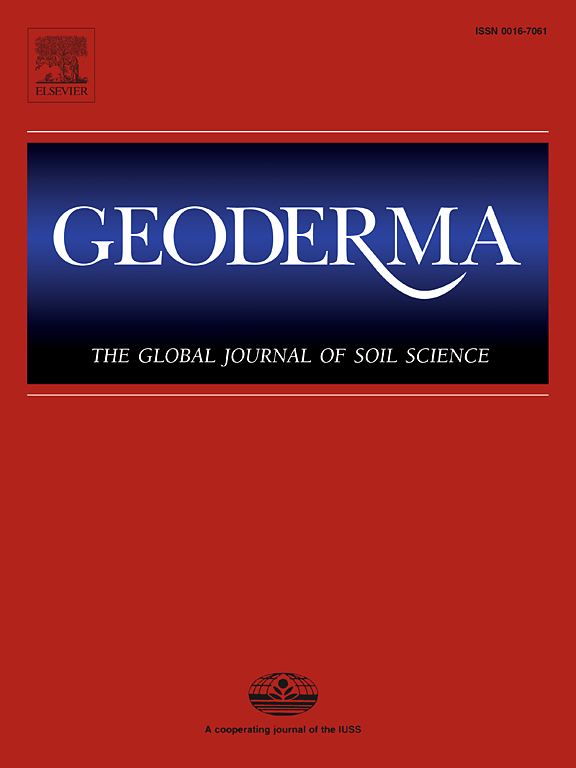亚热带酸性森林土壤异养硝化作用中活性碳对固定性氮分解的启动效应
IF 5.6
1区 农林科学
Q1 SOIL SCIENCE
引用次数: 0
摘要
顽固性有机氮(N)分解对土壤肥力和生态系统功能至关重要。虽然植物根系分泌物含有多种不稳定碳(C)源,可以刺激顽固氮分解,但不同不稳定碳在异养硝化过程中驱动这一过程的具体贡献尚未完全阐明。本研究考察了简单C处理的效果,即:柠檬酸(CA)、儿茶酚(CT)和葡萄糖(GLU);以及碳氮结合(C + N)处理,即葡萄糖+硫酸铵(GSA)、葡萄糖+甘氨酸(GA)、葡萄糖胺(ASS)和甘氨酸(GLY)对亚热带酸性森林土壤中顽固性有机氮异养硝化(ONrec)和矿化(MNrec)的影响以无机氮(硫酸铵,SA)作为甘氨酸(N)处理的对照处理。采用Ntrace模型估计ONrec和MNrec的毛利率。结果表明,C + N处理(0.143 ~ 1.953 mg N kg−1 d−1)的ONrec最高,其次是N处理(0.043 mg N kg−1 d−1)、C处理(0.003 ~ 0.009 mg N kg−1 d−1)和对照(0.003 mg N kg−1 d−1)。C + N处理对ONrec的积极影响主要是由于土壤溶解有机碳(DOC)的增加,可能是由于C-:N水解细胞外酶(例如(CBH + BG):LAP)的相对活性增强。此外,C + N处理中真菌和潜在异养硝化菌(如青霉菌、木霉和摩氏菌)丰度的增加也有助于其较高的ONrec率。相反,氮处理的MNrec最高(53.664 mg N kg−1 d−1),其次是C + N处理(25.438 ~ 59.088 mg N kg−1 d−1)、简单C处理(0.194 ~ 0.690 mg N kg−1 d−1)和CK处理(0.587 mg N kg−1 d−1)。与ONrec不同,MNrec主要是由全氮(TN)的增加驱动的,TN满足了大多数土壤微生物对N的需求。这些发现重新定义了我们通过ONrec和MNrec途径,特别是在植物-土壤生态系统中对顽固氮分解的理解。本文章由计算机程序翻译,如有差异,请以英文原文为准。

Priming effect of labile carbon on the decomposition of recalcitrant nitrogen via heterotrophic nitrification in a subtropical acidic forest soil
Recalcitrant organic nitrogen (N) decomposition is crucial for soil fertility and ecosystem function. Although it is well-established that plant root exudates, containing various labile carbon (C) sources, can stimulate recalcitrant N decomposition, the specific contribution of different labile C in driving this process through heterotrophic nitrification have yet to be fully elucidated. This study investigated the effects of simple C treatments—i.e., citric acid (CA), catechol (CT), and glucose (GLU); as well as combined carbon and nitrogen (C + N) treatments—i.e., glucose + ammonium sulphate (GSA), glucose + glycine (GA), glucosamine (ASS), and glycine (GLY)—on recalcitrant organic N heterotrophic nitrification (ONrec) and mineralization (MNrec) in a subtropical acidic forest soil. Inorganic nitrogen (as ammonium sulfate, SA) was included as a reference treatment for glycine (N treatment). The Ntrace model was employed to estimate the gross rate of ONrec and MNrec. Results unveiled that the highest ONrec developed in response to the C + N treatments (ranging from 0.143 to 1.953 mg N kg−1 d−1), followed by the N treatments (0.043 mg N kg−1 d−1), C treatments (ranging from 0.003 to 0.009 mg N kg−1 d−1), and the control (CK) (0.003 mg N kg−1 d−1). The positive impact of C + N treatments on ONrec was primarily driven by an increase in soil dissolved organic carbon (DOC), likely due to enhanced relative activity of C-:N-hydrolyzing extracellular enzymes (e.g. (CBH + BG):LAP)). Furthermore, the increased abundance of fungi and potential heterotrophic nitrifiers (e.g., Penicillium, Trichoderma, and Mortierella) in the C + N treatments also contributed to their higher ONrec rates. Conversely, the highest MNrec was observed in the N treatments (53.664 mg N kg−1 d−1), followed by the C + N treatments (ranging from 25.438 to 59.088 mg N kg−1 d−1), simple C treatments (ranging from 0.194 to 0.690 mg N kg−1 d−1), and CK (0.587 mg N kg−1 d−1). Unlike ONrec, MNrec was primarily driven by an increase in total nitrogen (TN), which fulfilled the N demand for most soil microorganisms. These findings redefined our understanding of recalcitrant N decomposition through the pathway of ONrec and MNrec, especially in plant-soil ecosystems.
求助全文
通过发布文献求助,成功后即可免费获取论文全文。
去求助
来源期刊

Geoderma
农林科学-土壤科学
CiteScore
11.80
自引率
6.60%
发文量
597
审稿时长
58 days
期刊介绍:
Geoderma - the global journal of soil science - welcomes authors, readers and soil research from all parts of the world, encourages worldwide soil studies, and embraces all aspects of soil science and its associated pedagogy. The journal particularly welcomes interdisciplinary work focusing on dynamic soil processes and functions across space and time.
 求助内容:
求助内容: 应助结果提醒方式:
应助结果提醒方式:


